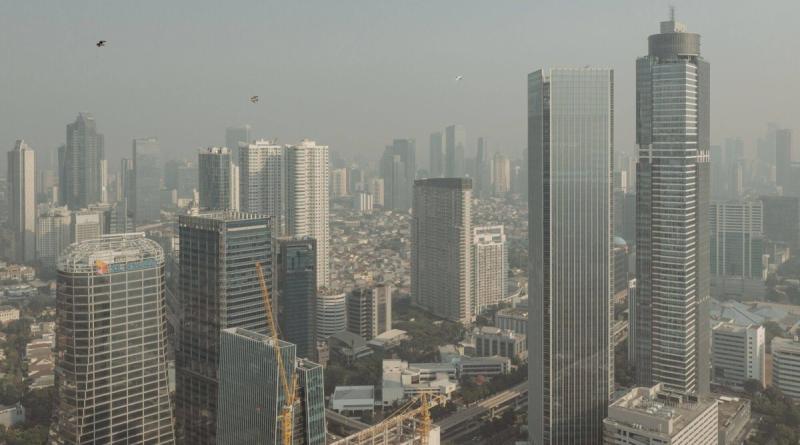Dark clouds ahead as Indonesia’s emissions surge from Asia’s need for data centres, Singapore’s offshore push

- Pollution woes are hampering Indonesia’s economic ambitions as more tech firms seek vast spaces for energy-intensive data centres across Asia
- Environmentalists say the data centre push, a lack of political will and financing interests will see Indonesia fall short of its climate goals
Indonesian tech worker Dennis cares about the environment but says he is in an impossible bind: he lives with his wife and five-year-old son in Bekasi, an industrial town east of Jakarta where the air is increasingly unbreathable – yet he fears his own job in tech is contributing to the damage.
“The air pollution is getting so bad,” he said, requesting to go by a pseudonym over fears of repercussions at his workplace. “My son and I had a bad cough that lasted almost a month.”
The 34-year-old works at a data centre – notoriously energy and water-intensive facilities chock-full of computer servers that store and distribute information, powering cloud computing but needing round-the-clock electricity, much of it still provided by burning coal.
As data usage in Asia rises, including through the adoption of artificial intelligence, major tech companies are looking for vast new spaces to store the explosion of information that’s being created.
Young, conscious of the climate crisis and concerned for his family’s health, Dennis’ situation is made more complex by the tenuous foothold he has in Indonesia’s rapidly growing digital economy. He worries that he might miss a golden opportunity if he and his family decide to move elsewhere.
“I’m not sure what the right thing to do is,” he said.
Jakarta is one of the fastest-growing data centre hubs in the Asia-Pacific, second only to Melbourne in Australia, according to a joint report published by property consultancy Knight Frank and data centre research platform DC Byte.
But environmental activists question whether in the rush for digital primacy, Indonesia risks compromising its own climate target of reaching net zero carbon emissions by 2060.
Meanwhile Singapore, the region’s digital leader which has its own stated aim of reaching net zero emissions a decade earlier, is seeking to park some of the high-carbon emissions produced by its data centres in neighbouring countries, including Indonesia.
Indonesia’s digital economy was valued at US$77 billion last year and it could be worth five times as much by 2030, making it the largest in Southeast Asia, according to a report by Google, Singapore state investor Temasek and consulting firm Bain & Company.
In parallel, demand for data centres to cater to the world’s fourth-largest population has surged, pulling in investment from tech behemoths Google, Microsoft, Amazon Web Services and Alibaba, owner of the South China Morning Post.
Indonesian President Joko Widodo has marked growing digitalisation as a priority. But environmental activists say they fear ineffective legislation to phase out coal plants means the country will remain reliant on non-renewable energy for its digital transformation, creating a knock-on effect on emissions.
Data centres accounted for up to 4 per cent of global greenhouse-gas emissions in 2022, according to a report by property consultancy JLL.
Interest from Singapore
There are around 94 data-centre operators in Indonesia with a combined capacity of 727.1 megawatts, according to PLN, Indonesia’s state-run electricity utility. The government wants to build four new national data centres by 2026, each with capacity of up to 40MW, with the “aim to unite the operations of at least 2,700 pre-existing government data centres”.
A 1MW data centre uses enough electricity to power up to 1,000 homes for a year and requires at least 26 million litres of water annually to cool its heat-generating servers.
Singapore paused domestic construction of new data centres in 2019 due to environmental concerns and space constraints. In 2021, the city state’s more than 70 data centre facilities were found to account for 7 per cent of total energy consumption.
The construction moratorium was lifted in July last year, but capacity was limited to ensure sustainability standards are met. Instead, Singapore has been looking to build data centres in neighbouring countries like Indonesia and Malaysia.
Singapore-based Princeton Digital Group (PDG) is offering capacity for companies wanting to build facilities offshore, including in Malaysia’s Johor Bahru and on Indonesia’s Batam island, which sits approximately 20km south of the city state.
“For large data centres, availability of affordable green power at scale is very important,” Varoon Raghavan, chief operating officer of PDG, said in an email to This Week in Asia.
“[Indonesia] has abundant natural resources and has a big potential for renewable energy development.”
It also benefits from its vast geographical size, according to Kevin Wee, a Singapore-based data-centre specialist and Asia-Pacific head at industrial heating supplier Reflex Winkelmann.
“Indonesia has enough land to build power plants and more data centres, and this number will continue to grow. Its size means that it can also spread its carbon emissions across a larger area.
“For places like Singapore, which are smaller, having too many data centres, power consumption and carbon emissions are an issue because everything is confined in a smaller space,” he said.
Risks of offshoring
Observers say there are real concerns that the climate goals of Singapore’s neighbours might be railroaded by any shunting of the city state’s responsibilities down the economic food chain.
“The risk of companies and investors trying to offshore their environmental challenges to countries like Indonesia is quite real,” said Putra Adhiguna, an energy specialist with the Institute for Energy Economics and Financial Analysis (IEEFA). “Not all companies have the same bar of standards in terms of sustainability.”
The cost of growth in Indonesia’s other industries, particularly nickel production, can be be counted in their high carbon emissions, energy experts say.
In the past three years, Indonesia has signed US$15 billion of deals with major carmakers to use its large nickel reserves to become a hub for electric vehicle batteries. Despite pledges to meet its climate goals, Indonesia approved the construction of new coal power plants specifically to support nickel processing.
“I think the very least that these companies can do is to disclose the environmental impacts of their existing activities in Singapore, and the comparison of when they offshore it, whether it is to Indonesia or Malaysia,” Putra said.
At a regulatory level, Indonesia’s mandatory reporting programme for energy consumption currently applies only to large energy consumers exceeding 70 gigawatt-hours per year.
But experts say most facilities have much smaller energy needs, making mapping the actual energy consumption of individual data centres impossible.
PDG’s Raghavan said that the Singapore-based company is committed to its sustainability goals and provides transparency on its reporting process in a report released annually.
The digital industry has also been very vocal about adopting sustainable practices, according to IEEFA’s Putra.
“No big company wants to be seen as offshoring its environmental problems to a more lax regulatory context like in Indonesia or Malaysia, that is not something that will go well for any company’s reputation,” Putra said.
Surface-level measures
Yet the issue of energy supply in Indonesia is complex.
Most data centres are reliant on PLN, the state-owned electricity company, unless they decide to build their own power plants or put solar panels on their facilities.
Even then, since data centres require a steady supply of power, it’s almost impossible to be self-sufficient. But PLN’s energy mix is heavy on coal input – its 2022 annual report said 67 per cent of power still comes from coal and only 14 per cent from renewables.
PLN also grants Renewable Energy Certificates (REC) to companies in Indonesia that are showing a commitment to using green electricity, but experts say these certificates can sometimes be surface-level measures.
“For some of these RECs, power is coming from existing geothermal or a hydropower plant that’s already been around for 30 years … so it’s a start but not really adding more renewable capacity on the ground,” Putra said.
Adila Isfandiari, a climate and energy campaigner for Greenpeace Indonesia, said it was hard to see the country reaching carbon neutrality unless more concrete efforts are made to shift away from a reliance on coal.
“With a lack of strong political will and financing interests, it is unlikely that Indonesia will be able to meet its climate goals,” she said.




